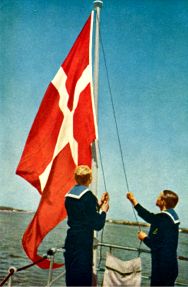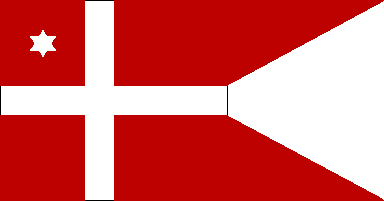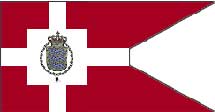|
You are here: 4The Flag 4The Naval Ensign |
|||||||||||||||||||||||||||||||||||||||||||||||||||||||||||||||||||
|
The Naval EnsignOrlogsflaget is the name During several hundreds of years, one of the important tasks of the Royal Danish Navy (RDN) has been the one of flying the colors.
The Naval Ensign of the RDN is in
Danish called "Orlogsflaget". Only ships of the regular navy are entitled to use the naval ensign. Navy establishments on land must use the normal swallow-tailed flag, the Dannebrog. One should notice that the naval ensign, Orlogsflaget, has a deeper red color than the Dannebrog. The History of the Naval Ensign There is no historical documentation revealing when Danish Men-of-War began flying the Dannebrog. The earliest painting showing Danish Men-of-War flying the Dannebrog, dates back to the 15th and 16th centuries. It was the Danish King Christian the IVth, who issued the known rules of flying the flag and flying the Colors of Command in the navy. This was done by the Royal War Articles on May 8, 1625. Naval Ensign and Jack In port and being at anchor the naval ensign is flying from a flagpole aft, at the same time a smaller naval ensign are flying as a jack at the stem. At sea the naval ensign are normally flying from a small gaff on the aft mast. In wartime and other periods of crisis the Naval Ensign will fly around the clock. Notice that the RDN do not strike the Naval Ensign at sunset, the ensign is lowered. The only situation, where the Navy will strike the Naval Ensign, is when capitulating. Colors of Command and Colors of Rank The RDN also use a number of Colors of Command an Colors of Rank together with the Naval Ensign. The Colors of Command indicates, not only that the person is on board, but also that this person has the formal Command; while the Colors of Rank only indicates that the person is on board the ship. The Colors of Command are hoisted at the moment the person enter the ship, and are lowered at disembarking.
The most widely used Colors of Command is the Naval Pennant. This pennant is flown from the ships mast around the clock and indicate that this ship is under command, i.e. manned and equipped. The Naval Pennant is a swallow tailed pennant, like the Naval Ensign. The Naval Pennant and the Squadron Commander's Pennant are not lowered, if the Commander temporally leaves the ship (the Command Post). The following Colors of Command are in use: The following Colors of Rank are in use: Listed below are the Danish Colors of Command and Colors of Rank:
44You are also referred to the Naval Bibliography
- Do you miss a major event on this Site,
Are you able to contribute to the unfolding of
the Danish Naval History, You can also use the Naval Web Forum on this web-site.
|
- |
|||||||||||||||||||||||||||||||||||||||||||||||||||||||||||||||||
|
This page was last updated: March 19, 2007 This page was first published: September 16, 2001 |
|||||||||||||||||||||||||||||||||||||||||||||||||||||||||||||||||||
|
Copyright © 2013-2016 Johnny E. Balsved - All rights reserved - Privacy Policy |
|||||||||||||||||||||||||||||||||||||||||||||||||||||||||||||||||||
















